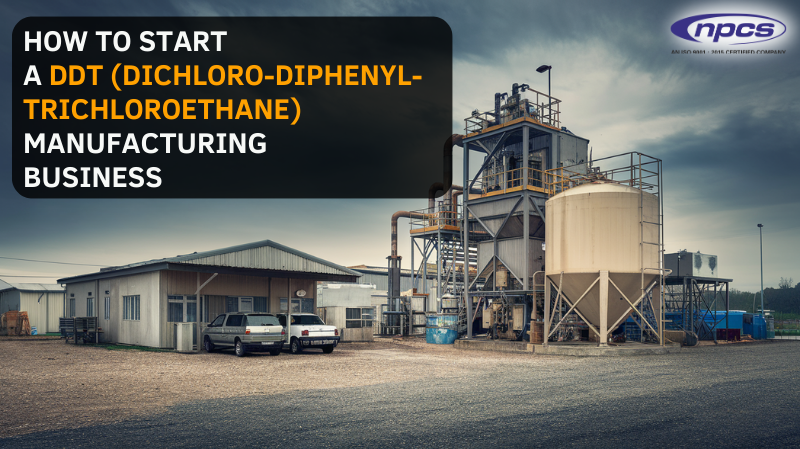People widely used DDT or Dichloro-Diphenyl-Trichloroethane, a synthetic historical pesticide, for agricultural and public health purposes, specifically for controlling malaria and typhus. DDT as a pesticide is a well-known insecticide. Regulatory bodies in many countries, however, have prohibited or limited the use of DDT due to serious environmental and health implications. Although specific countries are allowed to produce DDT, the product still draws public concern for its use. This guide will take you through the process of establishing a DDT product manufacturing business from understanding the product and its intended market, to business set up, implementation of production steps in the manufacturing process, and success tips.
What is DDT?
DDT as a product is an organochlorine compound, which was first synthesized in 1874, and became well known for its use during World War II, specifically in its ability to achieve biological control of environmental Caribbean mosquito diseases. It is a colorless solid or crystalline insecticide compound that is synthetic. DDT affects the nervous systems of insects, causing paralysis, and therefore can be used against a wide array of insects.
Join With Us
Why Start a DDT Manufacturing Business?
Producing DDT can be a rewarding and profitable business, especially in areas that still allow DDT use under public health conditions.Here are some potential benefits for purchasing the business:
- Public Health Needs: Public health officials still consider DDT a valuable tool to reduce or control vector-borne diseases in areas where they need to monitor malaria and other vectors.
- Use in Agriculture: DDT also is being used in certain areas of agriculture for pest control; though its use is restricted in many countries, there are niches and markets where DDT is used, particularly when some other alternatives are unsuccessful.
- Niche Area of Manufacturing: DDT’s use has been controversial; currently few if any companies are willing to produce DDT. Thus, as long as safety standards are maintained and legal assistance can be obtained, manufacturers will gain niche areas of the market.
- Exportation: There are still a few areas in the world which import DDT to be used as a controlled pesticide. The international market may remain a way to generate revenue. .
Benefits of Starting a DDT Business
- Market Demand and Need: DDT has utility in various regions which still suffer from diseases such as malaria or dengue. Therefore, the market for these areas may remain steady and dependable.
- Low Cost: The cost to produce DDT is generally less expensive than the production of a few other pesticides
- Longevity. DDT or dichloro-diphenyl-trichloroethane, as long as it is not covered with another insecticide, shows longevity.
- Regulated Area: Although some areas are closely regulated, these regulations also can offer less competition once you are able to adhere.
Read Similar Articles: Chemical Industry
Top Applications of DDT
Industrial uses for DDT include:
- Vector Control: DDT is certainly useful when controlling mosquitoes and other adult carrier insects, particularly when diseases such as malaria and dengue remain,
- Agricultural Control: Some farmers still utilize DDT for pest control in crops such as cotton, Canadian canola, soybeans, and peanuts, although most countries have diminished its use.
- Public Health Authorities: Organizational or governmental public health authorities (non- government) sometimes utilize DDT in public health campaigns or programs to control disease vectors.
Production Methods
DDT manufacturing does require significant investments in specialized equipment and safety considerations; however, the steps for starting a DDT manufacturing venture may very well be within reach and deserve consideration. The DDT manufacturing process can be summarized in the following technical steps:
- Raw Material Sourcing: The primary raw materials required for the manufacturing of DDT would be chloral and chlorobenzene. It would be necessary to obtain and constantly supply raw materials.
- Chemical Manufacturing: The manufacturing process for DDT involves the chemical reaction of chloral and chlorobenzene, respectively, with sulfuric acid for the manufacturing of DDT.
- Purification: The crude form of DDT is then purified through crystallization and filtration to yield the final product.
- Formulation: Based on the production objective, the DDT chemical product could be formulated into several forms such as, but not limited to, emulsifiable concentrates or wettable powders.
- Packaging and Shelving: The worker will package the DDT product into acceptable containers and then shelves in appropriate conditions when stored.
Essential Machinery for DDT Manufacturing
- Reaction Vessels: Where the chemical synthesis occurs.
- Filtration Units: For purification of the crude DDT for impurities
- Crystallizers: For the crystallization of DDT out of the reaction to form the crude DDT.
- Packaging Machines: For packaging the DDT into storage containers.
Related Feasibility Study Reports: Chemicals (Organic, Inorganic, Industrial) Projects
Starting Your DDT Manufacturing Business
To launch your DDT manufacturing business there are some necessary steps that are vital before investment:
Conducting market research.
Determine present market demand and existing consumers of DDT, such as, public health sectors and agricultural industry.
Understand the restrictions by personal protective measures in the region.
Developing a business plan.
Create a business plan that includes values, projected workers, and potential obstacles, the regulatory and environmental business difficulty; and risk management.
Seek stability and compliance of regulatory boards as it pertains to DDT regulations and standard sustainability of environmental regulations and protocols in compliance and at risk.
Create Manufacturing Infrastructure
Build a manufacturing facility with the required equipment and safety protocols.
Find a location where the production and use of DDT is legal at both the state and federal levels.
Raw Material Sourcing
Build a reliable supply chain for the raw materials necessary for DDT, especially chloral or chlorobenzene.
Consider a long-term contract purchasing arrangement to ensure timely availability of the raw materials for production.
Quality Control Implementation
Design a quality control program and follow through with procedures assuring quality of production, safety, weights and measures of raw materials, and overall product performance.
Conduct monitoring tests on raw materials, coordinate product manufacturing, and conduct routine and post product sampling testing and monitoring.
Build a Marketing & Sales Plan
Establish and build relationships with potential clients including government agencies and large agricultural businesses.
Participate in trade shows or trade fairs to promote your DDT product. Build an online presence establishing contact information.
Make Commitment to Research & Development
Invest R&D capacity to improve upon DDT product formulations and possible alternative DDT uses.
Stay current to the international DDT product agenda or program and commit to update planning, project scope statements, and R&D and use unobserved opportunities.
Conclusion
Launching a business providing DDT in a product or hybrid product may provide a niche or market opportunity in certain markets both local, state, and federal where creating or selling DDT or a product with DDT is still legal. Planning, complying with regulations, and manufacturing high quality will be incentives to meet sustainability goals. Adaptation to the latest trending news and keeping on top of regulations around continued DDT use is also a comparison between people.
With good planning, following legal requirements, and committing to quality standards, DDT manufacturing and supply of DDT, will provide significant upside opportunities for business to be a growth business in the chemical industry.






